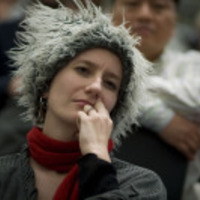Papers by Paweł Rybszleger
Zielsprache Deutsch, 2014

V&R unipress eBooks, Jan 18, 2021
Pragmatics of hashtags usingt he example of Twittera samultimodald iscourse system The aim of the... more Pragmatics of hashtags usingt he example of Twittera samultimodald iscourse system The aim of the article is hashtags' contribution to pragmatic meaninginthe online multimodal discourse system Twitter, by serving as the so-called ‚semiotic operators' in this context. From the perspective of the relevance theory of Wilson and Sperber, Iargue that, beingpragmatic and linguistic phenomena, hashtags not only contributetorelevance by adding alayer of activation to certain contextual assumptions of other usersbut also guide users' inferential processes. Moreprecisely, hashtags include information whichmay guide the user towards ag reter understanding of both explicity and implicity communicated meaning. They may also havesome stylistic consequences (usually addingtothe informal/ casual style of the communicated content). These assumptions are exempified by findings coming from ap ragmalinguistic analysis of ad ataset of 100 selected tweets in German coming from the hashtag #coronadeutschland.

In dem Beitrag wird das Problem der Wissensgenerierung,-vermittlung und des Wissensmanagements in... more In dem Beitrag wird das Problem der Wissensgenerierung,-vermittlung und des Wissensmanagements in sozialmedialen Umgebungen im Web 2.0 aufgegriffen. Es wird dabei angenommen, dass das wichtigste Element der Netzwerkgesellschaft in Bezug auf Web 2.0, das eine durchaus reziproke Kommunikation zulässt, die Einbeziehung der sog. vernetzten/kollektiven Intelligenz der User (Engl. networked intelligence) ist. Eine so verstandene Intelligenz kommt in unterschiedlichen Feldern zum Ausdruck (z. B. Bildung, Medien oder Politik) und bildet sich als Summe aller Beiträge der ‚Bürger' der Netzwerkgesellschaft im Internet. Veränderungen in Lernprozessen, in Politik und Wirtschaft unterliegen dabei einem übergeordneten Prinzip des sog. kollaborativen Handelns. Auf solchem Wege entstehen relativ lose themen-oder interessenorientierte soziale Netzwerke, deren Mitglieder u. a. an kollaborativen Projekten arbeiten (z. B. an Wikis), gemeinsam diverse Probleme lösen (z. B. auf thematischen Foren oder Blogs) oder auf andere Weise (z. B. durch Erstellen von multimedialen Elementen, die dann veröffentlicht werden) zum Aufbauen von gemeinsamen digitalen Wissensressourcen beitragen. Das im Text vorgestellte Modell der diskursiven Konstituierung von Wissen umfasst sowohl die Konstruktion von Wissen und seine argumentative Aushandlung als auch die Distribution (Teilen) und eventuelle Speicherung in digitaler Form. Darüber hinaus wird in dem Beitrag gezeigt, welche Rolle textuelle und multimediale Elemente im Prozess der Wissenskonstituierung spielen.
V&R unipress eBooks, Dec 12, 2022
Corona-Pandemie: Diverse Zugänge zu einem aktuellen Superdiskurs, 2022
This paper addresses the issue of self-presentation and pre-positioning of social media users of ... more This paper addresses the issue of self-presentation and pre-positioning of social media users of the platform Twitter. The author focuses on the anti-vaccination group (Covid-19) with its specific communication and recurring keywords that create a certain indexicality of the group and its linguistic ideologies around common symbols. On the basis of 100 selected self-presentation modules, the practices of positioning oneself – both at the level of text (descriptions, usernames) and at the level of multimodal elements of text (profile pictures and background pictures) – are shown (with concrete examples).
This paper addresses the issue of self-presentation and pre-positioning of social media users of ... more This paper addresses the issue of self-presentation and pre-positioning of social media users of the platform Twitter. The author focuses on the anti-vaccination group (Covid-19) with its specific communication and recurring keywords that create a certain indexicality of the group and its linguistic ideologies around common symbols. On the basis of 100 selected self-presentation modules, the practices of positioning oneselfboth at the level of text (descriptions, usernames) and at the level of multimodal elements of text (profile pictures and background pictures)are shown (with concrete examples).

Angewandte Linguistik – Neue Herausforderungen und Konzepte, 2021
Pragmatics of hashtags usingt he example of Twittera samultimodald iscourse system The aim of the... more Pragmatics of hashtags usingt he example of Twittera samultimodald iscourse system The aim of the article is hashtags' contribution to pragmatic meaninginthe online multimodal discourse system Twitter, by serving as the so-called ‚semiotic operators' in this context. From the perspective of the relevance theory of Wilson and Sperber, Iargue that, beingpragmatic and linguistic phenomena, hashtags not only contributetorelevance by adding alayer of activation to certain contextual assumptions of other usersbut also guide users' inferential processes. Moreprecisely, hashtags include information whichmay guide the user towards ag reter understanding of both explicity and implicity communicated meaning. They may also havesome stylistic consequences (usually addingtothe informal/ casual style of the communicated content). These assumptions are exempified by findings coming from ap ragmalinguistic analysis of ad ataset of 100 selected tweets in German coming from the hashtag #coronadeutschland.
Glottodidactica. An International Journal of Applied Linguistics, 2011
Zielsprache Deutsch, 2012

In dem Beitrag wird das Problem der Wissensgenerierung, -vermittlung und des Wissensmanagements i... more In dem Beitrag wird das Problem der Wissensgenerierung, -vermittlung und des Wissensmanagements in sozialmedialen Umgebungen im Web 2.0 aufgegriffen. Es wird dabei angenommen, dass das wichtigste Element der Netzwerkgesellschaft in Bezug auf Web 2.0, das eine durchaus reziproke Kommunikation zulässt, die Einbeziehung der sog. vernetzten/kollektiven Intelligenz der User (Engl. networked intelligence) ist. Eine so verstandene Intelligenz kommt in unterschiedlichen Feldern zum Ausdruck (z. B. Bildung, Medien oder Politik) und bildet sich als Summe aller Beiträge der ‚Bürger‘ der Netzwerkgesellschaft im Internet. Veränderungen in Lernprozessen, in Politik und Wirtschaft unterliegen dabei einem übergeordneten Prinzip des sog. kollaborativen Handelns. Auf solchem Wege entstehen relativ lose themenoder interessenorientierte soziale Netzwerke, deren Mitglieder u. a. an kollaborativen Projekten arbeiten (z. B. an Wikis), gemeinsam diverse Probleme lösen (z. B. auf thematischen Foren oder Blo...

The main issue discussed in the article is the generation, transfer and management of knowledge i... more The main issue discussed in the article is the generation, transfer and management of knowledge in the social media environment (Web 2.0). The author assumes that the most important thing of the networked society in relation to Web 2.0, which allows unlimited reciprocal communication, is the inclusion of the so called networked intelligence. Intelligence defined in this way manifests itself in different fields (e.g. education, media or politics) and is formed as a total of all online contributions made by ‘citizens’ of the networked society. Any changes in learning processes, in politics or economy are subjected to the paramount principle of collaborative action. In this way, relatively
loose specific subject- or interests-oriented social networks come into being, and their members may, for instance, work on collaborative projects (e.g. wikis), try to solve specific problems together
(e.g. on blogs or discussion forums), or contribute the creation of common digital knowledge resources in some other way. The presented model of discursive knowledge creation comprises both the construction of knowledge, its argumentative negotiation and its distribution (content sharing) plus possibly the storage of information in a digital form. In addition, the article presents the role of textual and multimedia elements in the process of knowledge creation.
Key words: knowledge, knowledge production, networked intelligence, collaborative activities, social media, social networking, user-generated content, sharing
The article focuses typical turns and sequences occuring in teenage Internet chats. The author us... more The article focuses typical turns and sequences occuring in teenage Internet chats. The author uses the American ethnomethodology and the German Gesprächsanalyse as methodology.
This text covers problems connected with defining linguistic concepts of
intertextuality and inte... more This text covers problems connected with defining linguistic concepts of
intertextuality and interfigurativeness of texts and images on the Internet. The author
focuses on some examples of combinations text-image (internet-memes). The most
important issues of this article are types and functions of such combinations on the Web.
Drafts by Paweł Rybszleger

G. Antos, R. Opiłowski, J. Jarosz (Hrsg.), Online-Diskurse im interkulturellen Gefüge. Wissenstransfer, Öffentlichkeiten, Textsorten (Reihe: Studien zur Medien- und Kulturlinguistik 1). Berlin u.a.. 247-270., 2018
DE: Rekontextualisierung, d.h. Einbettung von Äußerungen in andere neue Kontexte, stellt, besonde... more DE: Rekontextualisierung, d.h. Einbettung von Äußerungen in andere neue Kontexte, stellt, besonders in heutigen zahlreichen Online-Diskursen, ein besonders mächtiges Tool dar. Eine gewaltige Anzahl von Texten, Bildern und Videos unterliegt jeden Tag dem Prozess des Teilens, der zum einen Distribution bedeutet (vgl. semiotische Operatoren wie Hashtags oder Hyperlinks), zum anderen der Kommunikation online dient. Der Beitrag konzentriert sich auf die linguistische Analyse von ausgewählten Beispielen geteilter Inhalte (in Social Media), v.a. auf Teilen als Kommunikation in sozialer Umgebung.
EN: The entextualization, that is embedding of expressions in new contexts, is (especially in today’s discourses online) a very powerful tool. Many texts, images or videos are subject to the process of sharing. This process means both distribution (compare semiotic operators, hashtags or hyperlinks) and communication online itself. The article focuses on linguistic analysis of selected examples of shared content in the social media, first of all on sharing as communication in social environment.











Uploads
Papers by Paweł Rybszleger
loose specific subject- or interests-oriented social networks come into being, and their members may, for instance, work on collaborative projects (e.g. wikis), try to solve specific problems together
(e.g. on blogs or discussion forums), or contribute the creation of common digital knowledge resources in some other way. The presented model of discursive knowledge creation comprises both the construction of knowledge, its argumentative negotiation and its distribution (content sharing) plus possibly the storage of information in a digital form. In addition, the article presents the role of textual and multimedia elements in the process of knowledge creation.
Key words: knowledge, knowledge production, networked intelligence, collaborative activities, social media, social networking, user-generated content, sharing
intertextuality and interfigurativeness of texts and images on the Internet. The author
focuses on some examples of combinations text-image (internet-memes). The most
important issues of this article are types and functions of such combinations on the Web.
Drafts by Paweł Rybszleger
EN: The entextualization, that is embedding of expressions in new contexts, is (especially in today’s discourses online) a very powerful tool. Many texts, images or videos are subject to the process of sharing. This process means both distribution (compare semiotic operators, hashtags or hyperlinks) and communication online itself. The article focuses on linguistic analysis of selected examples of shared content in the social media, first of all on sharing as communication in social environment.
loose specific subject- or interests-oriented social networks come into being, and their members may, for instance, work on collaborative projects (e.g. wikis), try to solve specific problems together
(e.g. on blogs or discussion forums), or contribute the creation of common digital knowledge resources in some other way. The presented model of discursive knowledge creation comprises both the construction of knowledge, its argumentative negotiation and its distribution (content sharing) plus possibly the storage of information in a digital form. In addition, the article presents the role of textual and multimedia elements in the process of knowledge creation.
Key words: knowledge, knowledge production, networked intelligence, collaborative activities, social media, social networking, user-generated content, sharing
intertextuality and interfigurativeness of texts and images on the Internet. The author
focuses on some examples of combinations text-image (internet-memes). The most
important issues of this article are types and functions of such combinations on the Web.
EN: The entextualization, that is embedding of expressions in new contexts, is (especially in today’s discourses online) a very powerful tool. Many texts, images or videos are subject to the process of sharing. This process means both distribution (compare semiotic operators, hashtags or hyperlinks) and communication online itself. The article focuses on linguistic analysis of selected examples of shared content in the social media, first of all on sharing as communication in social environment.